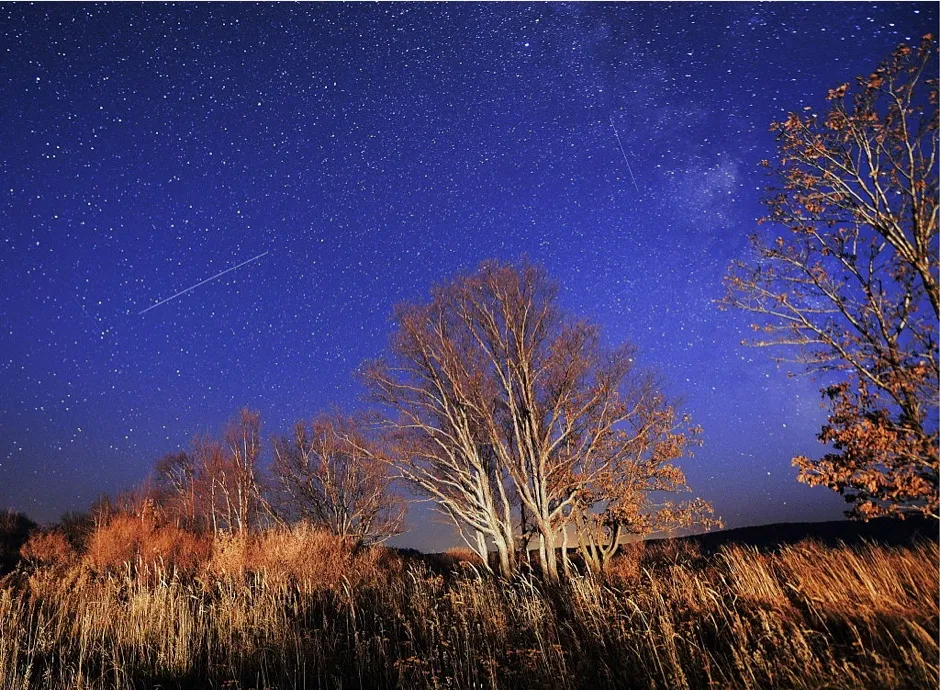Stargazers can look forward to catching the peak of the Orionidmeteor shower on Tuesday night and Wednesday morning. Up to 25 meteors per hour will light up the night sky, depending on the conditions in your area.
On any given night of stargazing, you can expect to see a couple of meteorsevery hour. Meteors, commonly known as ‘shooting stars’, are flashes of light caused by pieces of dust or rock burning up as they pass through the Earth’s atmosphere. Incredibly, these are usually the size of a grain of sand, but they travel so fast (about 66km/s) that they create a trail that glows as brightly as the stars.

Every so often, the Earth’s orbit brings us into a particularly dense patch of cosmic debris – a trail of rock and dust left in the wake of an asteroid or comet. We see this as a meteor shower.
The annual Orionid meteor shower has been building throughout October, and activity will peak on 20-21 October. While it might not be the most prolific annual meteor shower, NASA says that it is "one of the most beautiful".
It is associated with the most famous comet of all: Halley's Comet. Halley's Comet returns to its perihelion – its closest point to the Sun – every 76 years, which will next occur in 2061. It's not the only meteor shower associated with Halley's Comet – the Eta Aquariids takes places in May.
On the night of 20 October, the waxing crescent Moon will set at around 8:10pm, which means that the skies should be dark for observing the meteors. However, the best time to spot them will be after midnight.
Read more about stargazing:
- 9 stargazing tips to get you watching the stars from home
- A beginner's guide to stargazing, no telescope required
- How do I find the North Star?
Meteor showers are named after their radiant, that is, where they appear to originate from in the sky. The Orionid meteor shower, for example, appears to come from the Orion constellation.
To look for meteors, let your eyes adjust to the dark, then look directly up. Although the meteors originate from Orion, it’s not important to specifically find that constellation – they can travel across the whole sky. So make sure you can see as much sky as possible, without obstruction from buildings or trees, to give yourself the best chance.
Most importantly, make sure that you’re comfortable, by taking a chair (a reclining one is best), a blanket, and maybe even a flask of hot chocolate with you.
Don't worry if you miss out this time, the Taurid and Leonid meteor showers will be taking place in November.
Reader Q&A: How do we predict meteor shower intensity?
Asked by: Simon Foster, Burnley
Most ‘predictions’ of the rate of meteors per hour during meteor showers are based on both theory and observation. Essentially, a computer model is built containing the trajectories of every known comet – since it is the debris from comets that forms the ‘stream’ of particles we see during a meteor shower.
This model contains information on the rate that these comets release material, along with the sizes, directions and velocities at which they are released, as well as the gravitational forces that determine their subsequent trajectories through space. The trajectory of the Earth and the conditions of the Earth’s atmosphere are also inputted into the computer model.
By watching how Earth moves through the meteor stream it is possible to estimate the likely number of meteors that will be visible during a given shower for a given location.
But different astronomers use different models. Plus, these models are partly based on difficult measurements of the meteoric particles in the Solar System, so their predictions are often only approximate.
But generally, they can be used to reliably predict when a meteor shower is likely to be more or less intense than the average.
Read more:
